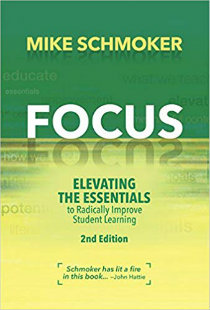Revolutionize Teaching with an ‘Essentials’ Focus
Focus: Elevating the Essentials to Radically Improve Student Learning, 2nd Edition
By Mike Schmoker
(ASCD, 2018 – Learn more)

Stop right here. Go buy this book: Focus: Elevating the Essentials to Radically Improve Student Learning, 2nd Edition, by Mike Schmoker. I’ll wait.
Are you back?
Good! Now, read on.
Get Ready for a Revolution

His solution focuses on three elements: what we teach, how we teach, and authentic literacy, and throughout the book he proves that “these elements are so potent, they need not be implemented perfectly or with any special skill. Their impact will be largely realized when most teachers simply apply them reasonably well and consistently” (8).
Sound too good to be true? That’s what I thought, too.
But it really works.
Don’t believe me, though. Try it yourself and see. Please. Our educational system is failing us, and unless we make the right changes, we will remain stagnant. Our kids need this. Our country needs this. We are each in a position to institute meaningful change, and it’s time we use our position to do what’s proven to be best instead of what’s been chosen as the “latest, greatest” method.
What We Teach
In the foreword to this second edition, Schmoker offers a detailed summary of updates, revisions and new material. He also makes this observation:
In the years since the first edition of this book was published, the case for the evidence-based elements advocated here has grown prodigiously: our best researchers now agree that their effect—if implemented—would be both rapid and dramatic.
Schmoker reminds us that the most important part of teaching is our curriculum. After all, how can we expect our students to learn something if we’re not teaching it to them? However, as every teacher can probably attest, there is no way we can teach everything we’re being told to teach in our standards documents. There is just not enough time. Instead, we need a curriculum that is viable, clear, rich in content, and infused with literacy—something that is sorely lacking in most of our schools today.
It really is simple: if we want our students to read better, they need to read more; if we want them to write better, they need to write more; if we want them to be better critical thinkers, they need to be challenged to think critically and explain their thinking more. As Schmoker says,
“…[T]here is compelling evidence that all students will benefit from a curriculum that embraces a ‘common academic core’ (that leaves adequate space for teachers to supplement the curriculum with some of their own content and creativity). What is less recognized is that to optimize and enliven learning, our curriculum must be liberally infused with frequent opportunities for students to read, discuss, argue, and write about what they are learning” (28).
Literacy matters.
But don’t worry—Schmoker lays out for you exactly how to create a viable, literacy-rich curriculum in English language arts and the content areas.
How We Teach
Developing a solid curriculum is the first part of the revolution, and teaching it effectively is the second. Schmoker points out that the keys to effective teaching are “as old as teaching itself” (56) and include the following: student attentiveness and engagement, clear learning objectives, explicit teaching, guided practice, checks for understanding, reteaching, and independent practice/assessment.
Done right, these elements have a profound effect on student learning. Schmoker cites a wealth of evidence to support this—and a wealth of evidence to show why it isn’t happening in most of our schools. (In short, we’re spending too much time and energy investing in unproven strategies like differentiated instruction, improperly implemented RTI and project-based learning, and faulty teacher evaluation templates.) He then goes into extensive detail about how to do it right so you can start to make immediate changes in your classroom.
Authentic Literacy Made Easy
The second section of the book is comprised of subject-specific chapters for the four core areas—English language arts, social studies, science, and math—that discuss more specifically how to focus your curriculum and incorporate authentic literacy into your class while upholding effective teaching practices. Going so far as to even supply lists of possible learning objectives for each area, Schmoker takes the guesswork out of how to revolutionize your teaching to help all students achieve success.
Still In Doubt?
I believe so strongly in what Schmoker has to say that I have purchased this book for my colleagues, recommended it to my administrators, and now am urging you to buy it. I have changed my own teaching and have seen immediate results—even though I know I still have a lot of improvement to make. You don’t need to take my word for it, though. Try it yourself. You have nothing to lose but so much to gain. Join the revolution :-)
Jennifer Peters is a middle-level educator with fourteen years experience teaching seventh and eighth grade English in a rural school district. She facilitates a professional learning community for seventh-and eighth-grade English, math, and Spanish teachers, co-facilitates a fifth- to eighth-grade professional learning community for English teachers, and mentors new and pre-service teachers. She is constantly striving to improve her teaching practice and enjoys helping others do the same. To her, the best reward a teacher can get is to see her students and colleagues grow and achieve.


































